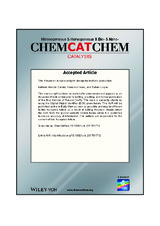Mostrar el registro sencillo del ítem
Advances in nanocatalysts design for biofuels production
| dc.contributor.author | Zuliani, Alessio | |
| dc.contributor.author | Ivars, Francisco | |
| dc.contributor.author | Luque, Rafael | |
| dc.date.accessioned | 2017-11-27T08:24:36Z | |
| dc.date.available | 2017-11-27T08:24:36Z | |
| dc.date.issued | 2017 | |
| dc.identifier.uri | http://hdl.handle.net/10396/15503 | |
| dc.description.abstract | The exploitation of nanocatalysts, at the boundary between homogeneous and heterogeneous catalysis, is tracking new efficient ways to produce renewable biofuels in environmentally friendly conditions. Their solid state makes them recyclable, and their nanomateric particle size enables high activities approaching those offered by homogeneous catalysts, as well as novel and unique catalytic behaviors not accessible to solids above the nanometer range. Furthermore, the use of magnetically active materials has led to the development of nanocatalysts easily recoverable through the application of magnetic fields. In this mini-review, latest achievements in the production of advanced biofuels using stable, highly active, cheap and reusable nanocatalysts are described. Specifically, biodiesel and high density fuels have been chosen as major topics of research for the design of catalytic nanomaterials. | es_ES |
| dc.format.mimetype | application/pdf | es_ES |
| dc.language.iso | eng | es_ES |
| dc.publisher | Wiley-VCH | es_ES |
| dc.rights | https://creativecommons.org/licenses/by-nc-nd/4.0/ | es_ES |
| dc.source | CHEMCATCHEM | es_ES |
| dc.subject | Nanocatalysis | es_ES |
| dc.subject | Biofuels | es_ES |
| dc.subject | Heterogeneous catalysis | es_ES |
| dc.subject | Green chemistry | es_ES |
| dc.title | Advances in nanocatalysts design for biofuels production | es_ES |
| dc.type | info:eu-repo/semantics/article | es_ES |
| dc.type | info:eu-repo/semantics/acceptedVersion | es_ES |
| dc.relation.publisherversion | http://dx.doi.org/10.1002/cctc.201701712 | es_ES |
| dc.relation.projectID | info:eu-repo/grantAgreement/EC/H2020-MSC-721290 | es_ES |
| dc.rights.accessRights | info:eu-repo/semantics/openAccess | es_ES |

